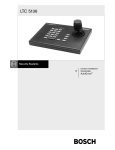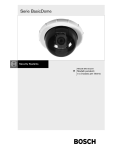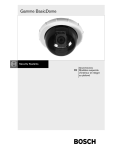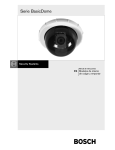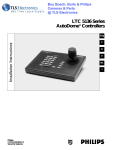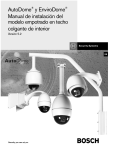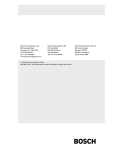Download Bosch LTC 5136/61 Instruction manual
Transcript
LTC 5136 Series Installation Instructions EN AutoDome® Controllers F.01U.284.614 LTC 5136 Series | Instruction Manual | Important Safeguards Important Safeguards 1. Read Instructions - All safety and operating instructions should be read before the unit is operated. 2. Retain Instructions - The safety and operating instructions should be retained for future reference. 3. Heed Warnings - All warnings on the unit and in the operating instructions should be adhered to. 4. Follow Instructions - All operating and use instructions should be followed. 5. Cleaning - Unplug the unit from the outlet before cleaning. Do not use liquid cleaners or aerosol cleaners. Use a damp cloth for cleaning. 6. Attachments - Do not use attachments not recommended by the product manufacturer as they may cause hazards. 7. Water and Moisture - Do not use this unit near water - for example, in a wet basement, near a swimming pool, in an unprotected outdoor installation, or in any area classified as a wet location. 8. Accessories - Do not place this unit on an unstable stand, tripod, bracket, or mount. The unit may fall, causing serious injury to a person and serious damage to the unit. Use only with a stand, tripod, bracket, or mount recommended by the manufacturer or sold with the product. Any mounting of the unit should follow the manufacturer's instructions and should use a mounting accessory recommended by the manufacturer. An appliance and cart combination should be moved with care. Quick stops, excessive force, and uneven surfaces may cause the appliance and cart combination to overturn. 9. Ventilation - This unit should not be placed in a built-in installation or rack, unless proper ventilation is provided, or the manufacturer’s instructions have been adhered to. The equipment must not exceed its maximum operating temperature requirements. 10. Power Sources - This unit should be operated only from the type of power source indicated on the marking label. If you are not sure of the type of power supply you plan to use, consult your dealer or local power company. For units intended to operate from battery power or other sources, refer to the operating instructions. Bosch Security Systems | 08 May 2013 EN | 2 11. Grounding or Polarization - This unit may be equipped with a polarized alternating-current line plug (a plug having one blade wider than the other). This plug will fit into the power outlet only one way. This is a safety feature. If you are unable to insert the plug fully into the outlet, try reversing the plug. If the plug should still fail to fit, contact your electrician to replace your obsolete outlet. Do not defeat the safety purpose of the polarized plug. Alternately, this unit may be equipped with a 3wire grounding-type plug, a plug having a third (grounding) pin. This plug will only fit into a grounding-type power outlet. This is a safety feature. If you are unable to insert the plug into the outlet, contact your electrician to replace your obsolete outlet. Do not defeat the safety purpose of the grounding-type plug. 12. Power Cord Protection - Power supply cords should be routed so that they are not likely to be walked on or pinched by items placed upon or against them, paying particular attention to cords and plugs, convenience receptacles, and the point where they exit from the appliance. 13. Power Lines - An outdoor system should not be located in the vicinity of overhead power lines or other electric light or power circuits or where it can fall into such power lines or circuits. When installing an outdoor system, extreme care should be taken to keep from touching such power lines or circuits as contact with them might be fatal. U.S.A. models only - refer to the National Electrical Code Article 820 regarding installation of CATV systems. 14. Overloading - Do not overload outlets and extension cords as this can result in a risk of fire or electric shock. 15. Object and Liquid Entry - Never push objects of any kind into this unit through openings, as they may touch dangerous voltage points or short out parts that could result in a fire or electric shock. Never spill liquid of any kind on the unit. 16. Servicing - Do not attempt to service this unit yourself as opening or removing covers may expose you to dangerous voltage or other hazards. Refer all servicing to qualified service personnel. EN | 3 LTC 5136 Series | Instruction Manual | FCC Information 17. Damage Requiring Service - Unplug the unit from the outlet and refer servicing to qualified service personnel under the following conditions: a. When the power supply cord or plug is damaged. b. If liquid has been spilled or objects have fallen into the unit. c. If the unit has been exposed to water and/or inclement weather (rain, snow, etc.). d. If the unit does not operate normally by following the operating instructions. Adjust only those controls that are covered by the operating instructions, as an improper adjustment of other controls may result in damage and will often require extensive work by a qualified technician to restore the unit to its normal operation. e. If the unit has been dropped or the cabinet has been damaged. f. When the unit exhibits a distinct change in performance--this indicates a need for service. 18. Replacement Parts - When replacement parts are required, be sure the service technician has used replacement parts specified by the manufacturer or have the same characteristics as the original part. Unauthorized substitutions may result in fire, electric shock, or other hazards. 19. Safety Check - Upon completion of any service or repairs to this unit, ask the service technician to perform safety checks to determine that the unit is in proper operating condition. 20. Coax Grounding - If an outside cable system is connected to the unit, be sure the cable system is grounded. U.S.A. models only--Section 810 of the National Electrical Code, ANSI/NFPA No.70, provides information with respect to proper grounding of the mount and supporting structure, grounding of the coax to a discharge unit, size of grounding conductors, location of discharge unit, connection to grounding electrodes, and requirements for the grounding electrode. 21. Lightning - For added protection of this unit during a lightning storm, or when it is left unattended and unused for long periods of time, unplug it from the wall outlet and disconnect the cable system. This will prevent damage to the unit due to lightning and power line surges. Bosch Security Systems | 08 May 2013 FCC & ICES Information (U.S.A. and Canadian Models Only) This device complies with part 15 of the FCC Rules. Operation is subject to the following two conditions: (1) This device may not cause harmful interference, and (2) This device must accept any interference received, including interference that may cause undesired operation. NOTE: This equipment has been tested and found to comply with the limits for a Class A digital device, pursuant to Part 15 of the FCC Rules and ICES-003 of Industry Canada. These limits are designed to provide reasonable protection against harmful interference when the equipment is operated in a commercial environment. This equipment generates, uses and radiates radio frequency energy, and if not installed and used in accordance with the instruction manual, may cause harmful interference to radio communications. Operation of this equipment in a residential area is likely to cause harmful interference, in which case the user will be required to correct the interference at his expense. Intentional or unintentional changes or modifications, not expressly approved by the party responsible for compliance, shall not be made. Any such changes or modifications could void the user’s authority to operate the equipment. If necessary, the user should consult the dealer or an experienced radio/television technician for corrective action. THIS IS A CLASS A PRODUCT. IN A DOMESTIC ENVIRONMENT, THIS PRODUCT MAY CAUSE RADIO INTERFERENCE, IN WHICH CASE, THE USER MAY BE REQUIRED TO TAKE ADEQUATE MEASURES. The user may find the following booklet, prepared by the Federal Communications Commission, helpful: How to Identify and Resolve Radio-TV Interference Problems. This booklet is available from the U.S. Government Printing Office, Washington, DC 20402, Stock No. 004-000-00345-4. LTC 5136 Series | Instruction Manual | Safety Precautions Safety Precautions CAUTION: TO REDUCE THE RISK OF ELECTRIC SHOCK, DO NOT REMOVE COVER (OR BACK). NO USER SERVICEABLE PARTS INSIDE. REFER SERVICING TO QUALIFIED SERVICE PERSONNEL. The lightning flash with an arrowhead symbol, within an equilateral triangle, is intended to alert the user to the presence of uninsulated “dangerous voltage” within the product’s enclosure that may be of sufficient magnitude to constitute a risk of electric shock to persons. The exclamation point within an equilateral triangle is intended to alert the user to presence of important operating and maintenance (servicing) instructions in the literature accompanying the appliance. Attention: Installation should be performed by qualified service personnel only in accordance with the National Electrical Code or applicable local codes. To meet the Mains Supply Voltage Dips and Short Interruptions requirements per EN 50130-4 Alarm Standard, ancillary equipment (for example, UPS) is necessary. The UPS must have a Transfer time between 2-6 ms and Backup Runtime of greater than 5 seconds for the power level as specified on the product data sheet. Power Disconnect. Units with or without ONOFF switches have power supplied to the unit whenever the power cord is inserted into the power source; however, the unit is operational only when the ON-OFF switch is in the ON position. The power cord is the main power disconnect for all units. Bosch Security Systems | 08 May 2013 EN | 4 LTC 5136 Series | Instruction Manual | Contents EN | 5 Table of Contents Important Safeguards . . . . . . . . . . . . . . . . . . . . . . . . . . . . . . . . . . . . . . . . . . . . . . . . . . . . . . . . . . . . . . . . . .2 FCC Information . . . . . . . . . . . . . . . . . . . . . . . . . . . . . . . . . . . . . . . . . . . . . . . . . . . . . . . . . . . . . . . . . . . . .2 1 UNPACKING . . . . . . . . . . . . . . . . . . . . . . . . . . . . . . . . . . . . . . . . . . . . . . . . . . . . . . . . . . . . . . . . . .6 2 SERVICE . . . . . . . . . . . . . . . . . . . . . . . . . . . . . . . . . . . . . . . . . . . . . . . . . . . . . . . . . . . . . . . . . . . . .6 3 DESCRIPTION . . . . . . . . . . . . . . . . . . . . . . . . . . . . . . . . . . . . . . . . . . . . . . . . . . . . . . . . . . . . . . . .6 3.1 Power . . . . . . . . . . . . . . . . . . . . . . . . . . . . . . . . . . . . . . . . . . . . . . . . . . . . . . . . . . . . . . . . . . . . . . . . .6 4 INSTALLATION . . . . . . . . . . . . . . . . . . . . . . . . . . . . . . . . . . . . . . . . . . . . . . . . . . . . . . . . . . . . . . .7 4.1 General . . . . . . . . . . . . . . . . . . . . . . . . . . . . . . . . . . . . . . . . . . . . . . . . . . . . . . . . . . . . . . . . . . . . . . .7 4.2 Installation using Biphase Code . . . . . . . . . . . . . . . . . . . . . . . . . . . . . . . . . . . . . . . . . . . . . . . . . . . . .7 4.3 Installation using RS-232 Data Direct to Camera Site . . . . . . . . . . . . . . . . . . . . . . . . . . . . . . . . . . .8 4.4 Installation using an RS-232 Data Transmission Link to a Biphase Camera Site . . . . . . . . . . . . . . .9 4.5 AutoDome Camera or Receiver/Driver Site Configuration . . . . . . . . . . . . . . . . . . . . . . . . . . . . . .10 5 SETTING FAST ADDRESS FEATURE . . . . . . . . . . . . . . . . . . . . . . . . . . . . . . . . . . . . . . . . . . . .10 6 CONTROLLER OPERATION . . . . . . . . . . . . . . . . . . . . . . . . . . . . . . . . . . . . . . . . . . . . . . . . . . .11 6.1 Controls/Indicators . . . . . . . . . . . . . . . . . . . . . . . . . . . . . . . . . . . . . . . . . . . . . . . . . . . . . . . . . . . . .11 7 TECHNICAL REFERENCE . . . . . . . . . . . . . . . . . . . . . . . . . . . . . . . . . . . . . . . . . . . . . . . . . . . . .13 8 DATA CONVERTER PINOUTS . . . . . . . . . . . . . . . . . . . . . . . . . . . . . . . . . . . . . . . . . . . . . . . . .16 Bosch Security Systems | 08 May 2013 EN | 6 LTC 5136 Series | Instruction Manual | Unpacking 1 UNPACKING This electronic equipment should be unpacked and handled carefully. Check for the following items: • LTC 5136/61 or LTC 5136/51 Desktop Controller. • Interface unit. • Power supply. • Power supply cable. • One (1) 3 m (10 ft) cable with two (2) RJ-11 connectors. If an item appears to have been damaged in shipment, replace it properly in its carton and notify the shipper. If any items are missing, notify your Bosch Security Systems, Inc. Sales Representative or Customer Service. The shipping carton is the safest container in which the unit may be transported. Save it for possible future use. 2 3 DESCRIPTION The LTC 5136 Series Controllers are designed for use with the Bosch AutoDome Series cameras. They can also be used to operate any of the conventional Allegiant® Series of Receiver/Drivers. The LTC 5136 Series controllers support control of all AutoDome and Allegiant receiver/driver functions including variable speed pan/tilt/zoom, pre-positions, auxiliaries, etc. Typically, one of the 16 outputs of the LTC 5136 junction box is connected to a single AutoDome camera or receiver/driver. If the application will use a daisy chain wiring configuration, up to eight (8) camera sites can be controlled from each of the 16 biphase outputs. The biphase control code cable can extend a maximum distance of 1.5 km (5000 ft), using 1.0 mm2 (18 AWG) shielded twisted pair cable (Belden 8760 or equivalent). 3.1 Power The model number and operating voltage are shown on the product label. SERVICE If the unit ever needs repair service, the customer should contact the nearest Bosch Security Systems, Inc. Service Center for authorization to return and shipping instructions. Service Centers U.S.A.: Phone: fax: e-mail: Canada: Europe, Middle 800-366-2283 or 408-956-3895 800-366-1329 or 408-956-3896 [email protected] 514-738-2434 East & Asia Pacific Region: 32-1-440-0711 For additional information, see www.boschsecuritysystems.com. NOTE: Grounded wrist straps must be worn and proper ESD safety precautions observed when handling the electrostatic-sensitive printed circuit boards. Bosch Security Systems | 08 May 2013 Model No. Rated Voltage Voltage Range Power at Rated Voltage LTC 5136/51 230 VAC, 50/60 Hz 195.5 to 253 6W LTC 5136/61 120 VAC, 50/60 Hz 105 to 132 6W EN | 7 LTC 5136 Series | Instruction Manual | Installation 4 INSTALLATION 4.2 Installation Using Biphase Code (See Figures 3 and 4) 4.1 General The desktop Controller unit should be installed in a location convenient to the operator. The Controller contains a single RJ-11 connector, which is used for both power and data connections. In most applications, the supplied 3 m (10 ft) power/data cable is connected directly to the supplied interface unit. The interface unit converts the RS-232 data generated by the Controller unit into Allegiant biphase control code. The interface unit also provides a path to connect power to the Controller unit. An LED visible on the top cover of the interface unit will flash to indicate that the RS-232 data coming from the Controller has successfully been converted into biphase control code. There are no video connections to the Controller. The video signal(s) from the camera site(s) should be connected to an appropriate viewing monitor, or other video processing equipment (switcher, multiplexer, etc.). If the application will utilize an RS-232 data communication link, or will be connected directly to RS-232 Series AutoDome cameras or RS-232 Allegiant Receiver/Driver units, the installation is done without using the supplied interface unit. For RS-232 applications, an LTC 8557 Series Remote Keyboard Hookup Kit should be purchased to simplify the installation process. One of the junction boxes supplied with the LTC 8557 Series Kit can then be used to connect the RS-232 wires TX and GND from the Controller’s output to the user-supplied RS-232 communication link. The RS-232 protocol requires a simplex link operating at 9600 baud. Three installation sections are detailed below; select the type of application you will be using. This document also includes various diagrams of typical applications, that will be helpful to refer to during installation. Bosch Security Systems | 08 May 2013 Install the supplied interface unit in a location close enough to the Controller unit so the that supplied 3 m (10 ft) data cable can be used. Note that the interface unit is rated for indoor use only. If desired, four holes are provided for mounting the interface unit to a flat surface. The power supply (to power the Controller and interface unit) should also be located in a convenient location near the interface unit. Connect the bayonet style connector of the power supply cable into the jack located on the side of the interface unit. If the power supply cable must be attached to the power supply, the polarity is not important; the Interface Unit is not polarity sensitive. Plug the power supply into a suitable AC power source. Connect the supplied 3 m (10 ft) data cable with two RJ-11 connectors, between the Controller unit and the interface unit. The orientation is not important -- either end may be connected to either device. The next step is to connect the biphase control code outputs of the interface unit to the data cables. Typically, a single camera site receiver/driver can be connected to each output, but the outputs of the interface unit are rated to handle up to eight (8) receiver/drivers when connected in a daisy chain configuration, to a maximum of 1.5 km (5000 ft). In a daisy chain connection, the cable is looped through each AutoDome camera or receiver/driver along the way. The last (and only the last) unit in the daisy chain connection should be terminated. All other receiver/ drivers should have the terminating resistor removed when the looping cable is connected. Connect shielded twisted pair cable (Belden 8760 or equivalent) between the camera site receiver/driver location and the biphase output connections located on the interface unit. EN | 8 LTC 5136 Series | Instruction Manual | Installation polarity sensitive. Plug the power supply into a suitable AC power source. Connect the supplied 3 m (10 ft) data cable with two RJ-11 connectors, between the Controller unit and the junction box. The orientation is not important -- either end may be connected to either device. Pin 1 Pin 6 Figure 1 Interface Unit Supplied with LTC 5136 The removable terminal blocks have three connections: (+), (–), and (S [Shield]), as shown in the diagram above. Select and maintain a wire color convention to avoid confusion at the camera site(s). Connect an appropriate length of cable (not supplied), suitable for use with RS-232 signals, between the LTC 8557 Series junction box, and the camera site receiver/driver location. If the distance between the box and camera site is much over 20-30 m (60-90 ft), the use of user-supplied short haul modems or other RS-232 line extender devices may be required. These devices must be able to support an RS-232 simplex transmission rate of 9600 baud. The LTC 8557 Series junction box provides a removable screw terminal block for the data connections. The terminal block has four connections, marked 1, 2, 3, & 4, as shown in the junction box diagram. EXAMPLE: White to (+), Black to (–), and Shield to (S). NOTE: The shield terminals (S) of the interface unit are connected to the shield wire of the cable. Skip to AutoDome Camera or Receiver/Driver Site Configuration to complete the installation. 4.3 Installation Using RS-232 Data Direct to Camera Site (See Figure 5) In this application, the RS-232 data that is generated by the Controller is connected directly to RS-232 Series AutoDome cameras or RS-232 Allegiant Receiver/Driver units. The supplied interface unit is not used in this application. The AutoDome camera or receiver/driver must be set (via internal DIP switch or on-screen menu) for 9600 baud operation. Install one of the junction boxes supplied in the LTC 8557 Series Kit (ordered separately) in a location close enough to the Controller unit so that the supplied 3 m (10 ft) data cable can be used. If desired, four holes are provided for mounting the LTC 8557 Series junction box to a flat surface. The power supply (to power the Controller) should also be located near the LTC 8557 Series junction box. Connect the bayonet style connector of the power supply cable into the jack located on the side of the junction box. If the power supply cable must be attached to the power supply, the polarity is not important; the Interface Unit is not Bosch Security Systems | 08 May 2013 Figure 2 Junction Box Supplied with LTC 8557 Series Kit Pins 1 and 2 are not used. Pin 3 is the Controller’s RS232 TX output, and Pin 4 is the Signal Ground connection. Connect the wire from terminal 3 to the RX connection of the AutoDome camera or receiver/ driver. Respectively, connect the wire from terminal 4 to the data ground connection. Only a single camera site can be connected in this manner – RS-232 signals cannot be wired using a daisy chain connection. Be sure to use cable suitable for RS-232 signals. Skip to AutoDome Camera or Receiver/Driver Site Configuration to complete the installation. LTC 5136 Series | Instruction Manual | Installation 4.4 Installation Using an RS-232 Data Transmission Link to a Biphase Camera Site (See Figure 6) In this application, the RS-232 data that is generated by the Controller is connected directly to an RS-232 transmission link (fiber optics, microwave, dial-up phone modems, etc.). The RS-232 transmission link must be able to support an RS-232 simplex transmission rate of 9600 baud. At the other end of the RS-232 transmission link, the RS-232 signal is converted into Allegiant biphase protocol, using the supplied interface unit. The biphase data is then connected to the AutoDome cameras or Allegiant receiver/driver units. Install one of the junction boxes supplied in the LTC 8557 Series Kit (ordered separately) in a location close enough to the Controller unit so that the supplied 3 m (10 ft) data cable can be used. If desired, four holes are provided for mounting the LTC 8557 Series junction box to a flat surface. The power supply (to power the Controller) should also be located near the LTC 8557 Series junction box. Connect the bayonet style connector of the power supply cable into the jack located on the side of the junction box. If the power supply cable must be attached to the power supply, the polarity is not important; the Interface Unit is not polarity sensitive. Plug the power supply into a suitable AC power source. Connect the supplied 3 m (10 ft) data cable with two RJ-11 connectors, between the Controller unit and the junction box. The orientation is not important -- either end may be connected to either device. Connect an appropriate length of cable (not supplied) suitable for use with RS-232 signals, between the LTC 8557 Series junction box and the RS-232 transmission device. If the distance between the box and device is much over 20-30 m (60-90 ft), the use of user-supplied short haul modems or other RS-232 line extender devices may be required. These devices must be able to support an RS-232 simplex transmission rate of 9600 baud. The LTC 8557 Series junction box provides a removable screw terminal block for the data connections. The terminal block has four connections marked 1, 2, 3, & 4. See Figure 2, Junction Box Supplied with LTC 8557 Series Kit. Pins 1 and 2 are not used. Pin 3 is the Controller’s RS-232 TX output, and Pin 4 is the Signal Ground connection. Be sure to use cable suitable for RS-232 Bosch Security Systems | 08 May 2013 EN | 9 signals. Connect the wire from terminal 3 to the RX connection of the RS-232 transmission device. Respectively, connect the wire from terminal 4 to the data ground connection. At the camera side of the RS-232 transmission device, install the interface unit in a convenient location where it can easily be connected to the transmission device. NOTE: The interface unit is rated for indoor use only. If desired, use the four holes provided to mount the box to a flat surface. Connect the bayonet style connector of the power supply cable into the jack located on the side of the interface unit. If the power supply cable must be attached to the power supply, the polarity is not important; the Interface Unit is not polarity sensitive. Plug the power supply into a suitable AC power source. Connect a transmit wire and a signal ground wire from the RS-232 transmission device to the desired input on the interface unit. Either the RJ-11 or the 9-pin D type connector input may be used. Refer to the Data Converter Pinouts section for the appropriate pin connections. Next, connect the biphase control code outputs of the interface unit to the data cable. Typically, a single camera site receiver/driver is connected to a single output, but each biphase output of the interface unit is rated to handle up to eight (8) receiver/drivers when connected in a daisy chain configuration, to a maximum of 1.5 km (5000 ft). For a daisy chain connection, the cable is looped through each AutoDome camera or receiver/driver along the way. The last (and only the last) unit in the daisy chain connection should be terminated. All other receiver/drivers should have the terminating resistor removed when the looping cable is connected. Connect shielded twisted pair cable (Belden 8760 or equivalent) between the camera site receiver/driver and the biphase output connections located on the interface unit. The removable terminal blocks have three connections: (+), (–), and (S [Shield]). See FIGURE 1, Interface Unit Supplied with LTC 5136. Select and maintain a wire color convention to avoid confusion at the camera site(s). Example: White to (+), Black to (–), and Shield to (S). NOTE: The shield terminals of the interface unit are connected to the Shield wire of the cable. EN | 10 LTC 5136 Series | Instruction Manual | Setting Fast Address 4.5 AutoDome Camera or Receiver/Driver Site Configuration Follow the standard installation instructions provided with the AutoDome Camera or Allegiant Series Receiver/Driver unit to connect the data cable to the unit. Set the address of the AutoDome camera or receiver/driver, to the camera number that will be selected on the Controller keypad. AutoDome cameras also support address setting via the on-screen menu Fast Address feature. The next section outlines setting of the AutoDome’s Fast Address. Video signals from the camera site are NOT connected to the Controller. The video signal(s) from the camera site(s) should be connected to an appropriate viewing monitor or other video processing equipment (switcher, multiplexer, etc.). 5 SETTING FAST ADDRESS FEATURE • ON-998-ENTER causes all cameras, regardless of Fast address status, to enter the addressing mode. Figure FA1 3. Press ON-26-ENTER. The screen shown in FIGURE FA2 will be displayed. At this point, any camera whose ID does not begin with 26 will exit the Fast Addressing mode. Use the AutoDome’s Fast Address feature to set the AutoDome address via the controller and on-screen menus instead of using the switch address (thumbwheel). Fast Address can also be used to change addresses, even if the thumbwheel switch is set. The following is an example of how to Fast Address an AutoDome (ID number 26636, logical camera #3). The AutoDome being Fast Addressed has the switch address (thumbwheel) set to 0. 1. Call up the camera to the screen you are viewing (i.e. CAM ERA-3-ENTER). 2. Press ON-999-ENTER. The screen shown in FIGURE FA1 is displayed. • Any camera without a Fast Address will display the screen in FIGURE FA1 when the ON-999-ENTER is used. Make sure you are viewing the camera that you want to program. • If the camera’s Fast Address is the same as the keyboard address, ON-999-ENTER will make the camera enter the Fast Address mode. This is required to change or disable a Fast Address. Figure FA2 4. Press ON-636-ENTER. The screen shown in FIGURE FA3 is displayed. At this point, Camera ID 26636 will be the only camera in the Fast Addressing mode. Figure FA3 Bosch Security Systems | 08 May 2013 EN | 11 LTC 5136 Series | Instruction Manual | Controller Operation 5. Press ON-1-ENTER and the address is set. Once the Fast Address is set, the switch address (thumbwheel) is ignored. The Fast Address is stored to non-volatile memory, and will not change if power is removed or factory defaults are restored (SET-899-ENTER). 6 • To reset the dome’s address to the switch address (thumbwheel), repeat the above steps and end by pressing OFF-1-ENTER. • To check/confirm the address, call up the camera and press ON-997-ENTER. This command causes all cameras to briefly display their addresses. CONTROLLER OPERATION Operation is quite simple. If the camera number to be controlled is not visible in the LED displays, use the numeric keypad to select the desired camera, then press ENTER. The camera can now be operated using the appropriate joystick and/or lens controls. If appropriate, pre-position scenes and auxiliary functions can also be entered. Note that a delay of more than 3-4 seconds while entering a selection results in the Controller returning to the default camera entry mode. If this condition occurs, start the selection again, from the beginning. A complete description of the controls and indicators is provided in the next section. 6.1 Controls/Indicators LED Indicators: The four digit, 7-segment LED display is used to display data entry and the selected camera number. SET key: This key is used to set pre-position scenes of all AutoDome cameras and Allegiant Series Receiver/ Drivers which are equipped with this option. Operate the joystick and lens controls to position the camera to the desired scene to be programmed. Press SET, then enter the desired pre-position number on the numeric keypad (1 to 99). Press ENTER to store the position. Certain pre-position numbers are also used to program certain AutoDome features. Refer to the AutoDome operation manual for a complete listing of the available features. USER key: Press USER-1-ENTER to enter the Controller diagnostic mode. This function can be used Bosch Security Systems | 08 May 2013 to ensure that all Controller LEDs and buttons are in working order. It also automatically calibrates the center position of the analog joystick. Upon entering this mode, the Controller sounds a short beep. The display readouts and LEDs behind the first two rows of buttons also illuminate for about two seconds. During this time, the joystick undergoes calibration, so be careful not to move it until the LED displays have gone dark. The operator should note any LED display failures during the time they are illuminated. Each key may now be pressed to display a unique code number associated with that key. Use the table below to ensure that all keys are operating properly. Push the USER key last, as this will cause the Controller to exit the test mode. Key Number Key Number Set 0009 9 0029 Camera 0025 0 0014 Shot 0010 Enter 0030 On 0018 Clear 0038 Off 0026 Focus (up) 0043 1 0011 Focus (down) 0044 2 0019 Iris (up) 0045 3 0027 Iris (down) 0046 4 0012 Up 1x53 5 0020 Down 0x51 6 0028 Left 1x52 7 0013 Right 0x54 8 0021 Zoom (CW) 1x41 Zoom (CCW) 0x42 NOTE: The x digit shown in the number column, for up, down, left, right, and zoom values, indicates a speed value, and will change based on how far the control is activated. LTC 5136 Series | Instruction Manual | Controller Operation CAMERA key: This key is only used to correct an error when selecting a camera number. If another key is inadvertently pressed when a camera selection is being made, the Camera button may be pressed to put the Controller immediately back into camera selection mode. Normally, a camera selection is made by entering the desired camera number using the numeric keypad, then pressing ENTER. SHOT key: This key is used to recall pre-position scenes of all AutoDome cameras and Allegiant Series Receiver/Drivers that are equipped with this option. Press SHOT, then enter the desired pre-position number on the numeric keypad (1 to 99). Press ENTER to recall a previously stored camera position. Certain pre-position numbers are also used to program certain AutoDome features. Refer to the AutoDome operation manual for a complete listing of the available features. ON key: This key is used to activate auxiliary functions of the AutoDome cameras and Allegiant Series receiver/drivers. Press ON, then enter the desired auxiliary number on the numeric keypad, and press ENTER to complete the action. Certain auxiliary numbers are also used to program certain AutoDome features. Refer to the AutoDome operation manual for a complete listing of the available features. OFF key: This key is used to deactivate auxiliary functions of the AutoDome cameras and Allegiant Series Receiver/Drivers. Press OFF, then enter the desired auxiliary number on the numeric keypad, and press ENTER to complete the action. Certain auxiliary numbers are also used to program certain AutoDome features. Refer to the AutoDome operation manual for a complete listing of the available features. Bosch Security Systems | 08 May 2013 EN | 12 NUMERIC keypad: These keys are used to enter numeric data. When the first numeric key is pressed, the LED display will become a data display and indicate the numeric value pressed. ENTER key: This key is used to terminate commands. When using the ON or OFF function, holding this key will cause the function to repeat until the key is released. This feature is useful where auxiliary functions are associated with level type camera adjustments. CLEAR key: This key is used to clear invalid entries. In some cases, it can be pressed twice. If there is numeric data in the camera display, the first push clears this data, and the second push returns the Controller to the camera mode. This allows the operator to clear incorrect data without leaving the current mode. If there is no data in the LED display, the first push clears the entire Controller, back to the default state. FOCUS and IRIS keys: These rocker switches are used to control the lens focus and iris functions. Joystick: Movement of the joystick left or right will pan the selected camera left or right. Movement of the joystick up or down will tilt the camera up or down. Rotation of the joystick knob will move the zoom lens in or out. If the camera is capable of variable speed operations, the degree of joystick deflection (or rotation) will correspond to different speed responses. EN | 13 LTC 5136 Series | Instruction Manual | Technical Reference 7 TECHNICAL REFERENCE Video Monitor Video Signal Power Supply Adapter Data Converter Unit DVR or Video Switcher Video Signal Up to 16 biphase control code outputs RS-232 Data & Power Typical AutoDome Cameras or Allegiant Receiver/Driver units Controller Figure 3 Typical Camera Site Using Biphase Control Code Video Signal Video Monitor Video Signal Video Signal DVR or Video Switcher Power Supply Adapter Daisy Chain Biphase Data Daisy Chain Biphase Data Data Converter Unit Typical biphase control code output RS-232 Data & Power Controller Typical AutoDome Cameras or Allegiant Receiver/Driver units Figure 4 Typical Multiple Camera Sites Using Daisy Chain Biphase Control Code Wiring Configuration Bosch Security Systems | 08 May 2013 EN | 14 LTC 5136 Series | Instruction Manual | Technical Reference Video Monitor Video Signal Power Supply Adapter LTC 8557 Junction Box RS-232 Cable or Communication Link RS-232 Data & Controller Typical AutoDome Camera or Allegiant Receiver/Driver unit Power Figure 5 Typical Installation Using RS-232 Model Camera Site Video Monitor Video Signal Video Signal Data Power Supply Biphase Converter Unit Data Biphase Adapter Data DVR or Video Switcher Power Supply RS-232 Data Adapter LTC 8557 Junction Box Controller RS-232 Data & Power RS-232 Cable or Communication Link Typical AutoDome Cameras or Allegiant Receiver/Driver units Figure 6 Typical Installation Using RS-232 Communication Link to Biphase Camera Site Bosch Security Systems | 08 May 2013 EN | 15 LTC 5136 Series | Instruction Manual | Technical Reference Pin 6 Pin 1 Pin 1 Pin 6 Figure 7 Supplied 6-Conductor 3 m (10 ft) Data Cable Detail Connector Pinouts: 1. 12V 2. Not used 3. Rx (Not used) 4. Tx 5. Signal Ground 6. 12V Pin 6 Pin 1 Figure 8 Rear Panel Controller Connector Detail 154 6.08 127 5.0 122 4.80 108 4.26 38 1.5 132 5.2 70 2.75 mm in Figure 9 Mounting Dimensions of Supplied Interface Box Bosch Security Systems | 08 May 2013 mm in LTC 5136 Series | Instruction Manual | Data Converter Pinouts 8 DATA CONVERTER PINOUTS Data In - 9-Pin Connector (Male) Pin Connection 1 No Connection 2 Rx 3 No Connection 4 No Connection 5 Ground 6 No Connection 7 No Connection 8 No Connection 9 No Connection KBD - RJ-11 Designations (If Used) Pin Connection 1 Output Voltage 2 Signal Ground 3 Rx 4 Ground 5 No Connection 6 Output Voltage Bosch Security Systems | 08 May 2013
















